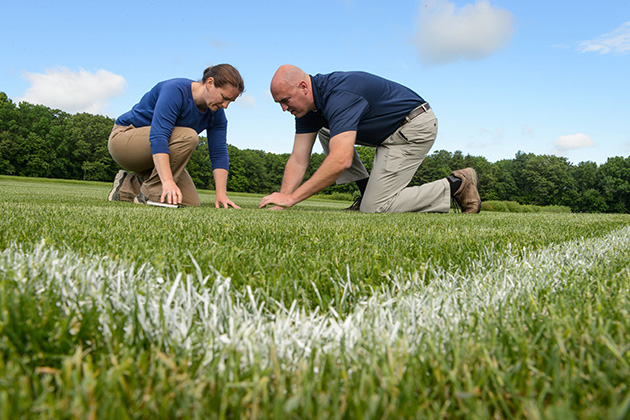
Determining ways to maintain athletic fields without pesticides can cause even the best turf managers to stumble – literally.
There is a fine line between aesthetics and safety when talking about athletic fields, according to UConn researchers who are studying the best practices to comply with a four-year-old law banning pesticide use on school grounds that serve students through grade eight.
“People are used to seeing lush green grass, but they are uncomfortable using pesticides to keep the fields in good shape,” says Julie Campbell, a Ph.D. student in plant science. “That means other strategies have to be developed that protect the fields from the kind of overuse that can lead to uneven ground or rough patches that may cause falls or other injuries.”
The information currently has implications for more than a half million school children across Connecticut who participate in organized sports on school athletic fields and in parks. This year, there was even discussion among lawmakers about widening the pesticide ban to include students through grade 12, although the bill did not pass.
There are a lot of new issues that arise when conventional methods are no longer available, and it’s our responsibility to introduce alternative techniques. — Julie Campbell
In essence, if a lawn care product has an Environmental Protection Agency (EPA) registration number it cannot be used on school grounds. But pesticide-free methods of management are not well established. There is a lot of misinformation about how to manage turf with and without pesticides, according to Jason Henderson, associate professor of turfgrass and soil sciences.
Henderson and Campbell are currently cultivating grass plots where they will study a number of different management systems, including integrated pest management strategies, and organic and synthetic fertilizers containing man-made inorganic compounds.
The research is supported by a grant from the EPA, a funding program that goes back to the early 1960s, when the publication of Rachel Carson’s book Silent Spring caused concern among the general public about the potential negative impact of pesticides on the environment.
“A lot of people think that using organic products simplifies things, but that’s really not the case,” says Campbell. For example, applying compost when phosphorous values in the soil are already adequate may result in more that is needed, which makes it susceptible to runoff. And runoff can create unintended environmental issues in surface and ground water, she says.
Henderson notes that one of the things researchers are tracking is how much of a particular pesticide stays in the soil after application, and how much residue is left on the surface, so medical experts can evaluate the risk of exposure to the end user.
After evaluating the best ways to reach the goal of cultivating fields with the ability to withstand weeds, insects, and disease pressures, the UConn researchers plan to train turf professionals on how to employ the information in their own management of athletic fields.
“There are a lot of new issues that arise when conventional methods are no longer available,” says Campbell, “and it’s our responsibility to introduce alternative techniques.”
The homeowner’s dilemma
The issue of pesticide use in public areas is an emotional one that more and more homeowners are facing when it comes to their own lawn maintenance.
“People need to know enough to ask the right questions. If a company wants to treat broadleaf weeds in July, the homeowner should know that is not the right time to do it,” says Henderson. “We tell people not to sign up for programs where treatments are determined solely by a date on the calendar, but to make educated decisions that pertain to their own lawns and their individual situations.”
Homeowners should start with a high quality turfgrass seed that is genetically suited to perform well in a particular environment – whether in a shady spot in the front yard or a sun-filled area by the backyard pool. Selecting improved varieties of turfgrass in each species may be more expensive, says Henderson, but they will have better color, quality, density, disease and insect resistance, and drought tolerance compared to varieties of lesser quality.
For information on sustainable home and garden care visit sustainableliving.uconn.edu/index.php



